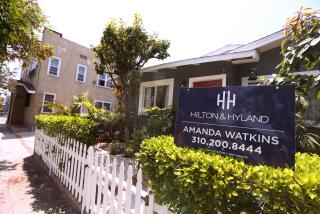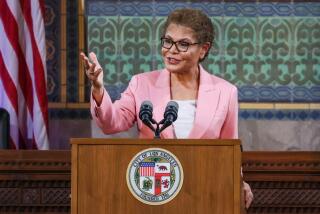Where Seeing Is Believing
A novel bus tour of inner-city Los Angeles brought bankers, appraisers, brokers and other real estate professionals face to face with the potential for profits in South-Central and on the Eastside. That bus ride could pay off not only for residents who are seeking home mortgages and business loans but for lenders too.
Banks can help a neighborhood flower through fair lending practices that encourage home ownership and commercial development. But far more commonly, lenders break the back of an inner-city neighborhood through redlining that restricts credit and stifles economic life.
Redlining is the rule rather than the exception in minority neighborhoods in South-Central and East Los Angeles. Too often the discrimination is based on race or ethnicity.
The L.A. riots spotlighted the pervasive problem. In minority neighborhoods, African-American and Latino mortgage or business loan applicants are often required to clear higher hurdles than white applicants with similar credit profiles.
The tour emphasized the opportunities for home ownership and rehabilitation, the development of small, affordable rental properties and the financing of businesses such as grocery stores. But lending in these areas need not amount to charity.
“I can tell you it’s good business,” Mario Antoci, chairman of the Irvine-based American Savings, said. “Problem loans in South-Central are one-third to one-half the rate in West Los Angeles, a much more affluent area,” said the top banker, who deserves applause for serving low-income communities while making profits for his financial institution.
Antoci went along for the bus ride, sponsored by Los Angeles Neighborhood Housing Services Inc., a nonprofit housing developer and advocate.
Three busloads of potential investors began their tour at the Afro-American Museum in Exposition Park near the campus of USC. They also traveled through Boyle Heights, the Mid-City area near the First AME Church and west toward the Crenshaw district.
What they saw was an underdeveloped land of opportunity where home prices typically are between $140,000 and $165,000. That range is affordable for many two-income couples--if they can get a mortgage. When traditional banks and savings and loans reject them, families often turn in desperation to “hard” money lenders who charge interest rates as high as 20% and collect as much as 10 points to do the deal. That can begin a cycle of debt that’s hard to break.
Neighborhoods thrive when residents have a stake in them via home or business ownership. As the tour guide pointed out: It’s good for the neighborhood. It can also be good for the bank’s bottom line.
More to Read
Inside the business of entertainment
The Wide Shot brings you news, analysis and insights on everything from streaming wars to production — and what it all means for the future.
You may occasionally receive promotional content from the Los Angeles Times.










